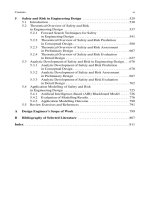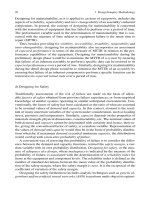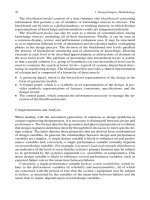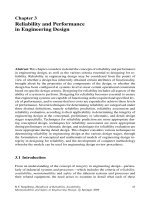Handbook of Reliability, Availability, Maintainability and Safety in Engineering Design - Part 32 docx
Bạn đang xem bản rút gọn của tài liệu. Xem và tải ngay bản đầy đủ của tài liệu tại đây (64.92 KB, 10 trang )
3.5 Review Exercises and References 293
Kerscher W, Booker J, Bement T, Meyer M (1998) Characterizing reliability in a product/process
design-assurance program. In: Proc Int Symp Product Quality and Integrity, Anaheim, CA, and
Los Alamos Lab Rep LA-UR-97-36
Klir GJ, Yuan B (1995) Fuzzy sets and fuzzy logic theory and application. Prentice Hall, Engle-
wood Cliffs, N J
Kuipers B (1990) Qualitative simulation. Artificial Intelligence 29(3):289–338 (1986), reprinted in
Qualitative reasoning about physical systems, Morgan Kaufman, San Mateo, CA, pp 236–260
Laviolette M, Seaman J Jr, Bar rett J, Woodall W (1995) A probabilistic and statistical view of
fuzzy methods. Technometrics 37:249–281
Lee RCT (1972) Fuzzy logic and the resolution principle. J Assoc Computing Machinery 19:109–
119
Liu JS, Thompson G (1996) The multi-factor design evaluation of antenna structures by parameter
profile analysis. Proc Inst Mech Engrs Part B, J Eng Manufacture 210:449–456
Loginov VI (1966) Probability treatment of Zadeh membership functions and their use in pattern
recognition. Eng Cybernetics 68–69
Martz HF, Almond RG (1997) Using higher-level failure data infault tree quantification. Reliability
Eng System Safety 56(1):29–42
Mavrovouniotis M, Stephanopoulos G (1988) Formal order of magnitude reasoning in process
engineering. Computers Chem Eng 12:867–881
Meyer MA, Booker JM (1991) Eliciting and analyzing expert judgment: a practical guide. Aca-
demic Press, London
Meyer MA, Butterfield KB, Murray WS, Smith RE, Booker JM (2000) Guidelines for eliciting
expert judgement as probabilities or fuzzy logic. Los Alamos Natl Lab Rep LA-UR-00-218
MIL-STD-721B (1980) Definition of terms for reliability and maintainability. Department of De-
fense (DoD), Washington, DC
MIL-STD-1629 (1980) Procedures for performing a failure mode, effects, and criticality analysis.
DoD, Washington, DC
Moore R (1979) Methods and applications of interval analysis. SIAM, Philadelphia, PA
Moss TR, Andrews JD (1996) Reliabilityassessment of mechanical systems. Proc Inst Mech Engrs
vol 210
Natvig B (1983) Possibility versus probability. Fuzzy Sets Systems 10:31–36
Norwich AM, Turksen IB (1983) A model for the measurement of membership and the conse-
quences of its empirical implementation. Fuzzy Sets Systems 12:1–25
Orchard RA (1998) FuzzyCLIPS Version 6.04A. Integrated Reasoning, Institute for Information
Technology, National Research Council Canada
Ortiz NR, Wheeler TA, Breeding RJ, Hora S, Meyer MA, Keeney RL (1991) The use of e xpert
judgment in NUREG-1150. Nuclear Eng Design 126:313–331 (re vised from Sandia Natl Lab
Rep SAND88-2253C, and Nucl ear Regulatory Commission Rep NUREG/CP-0097 5, pp 1–25
Pahl G, Beitz W (1996) Engineering design. Springer, Berlin Heidelberg New York
Payne S (1951) The art of asking questions. Princeton University Press, Princeton, NJ
Raiman O (1986) Order of magnitude rea soning. In: Proc 5th National Conf Artificial Intelligence
AAAI-86, pp 100–104
ReliaSoft Corporation (1997) Life data analysis reference. ReliaSoft Publ, Tucson, AZ
Roberts FS (1979) Measurement theory. Addison-Wesley, Reading, MA
Ryan M, Power J (1994) Using fuzzy logic—towards intelligent systems. Prentice-Hall, Engle-
wood Cliffs, N J
Shen Q, Leitch R (1993) Fuzzy qualitative simulation. IEEE Trans Systems Man Cybernetics
23(4), and J Math Anal Appl 64(2):369–380 (1993)
Shortliffe EH (1976) Computer-b ased medical consultation: MYCIN. Elsevier, New York
Simon HA (1981) The s ciences of the art ificial. MIT Press, Cambridge, MA
Smith RE, Booker JM, Bement TR, Meyer MA, Parkinson WJ, Jamshidi M (1998) The use of fuzzy
control system methods for characterizing expert judgment uncertainty distributions. In: Proc
PSAM 4 Int Conf, September, pp 497–502
Sosnowski ZA (1990) FLISP—a language for processing fuzzy data. Fuzzy Sets Systems 37:23–32
294 3 Reliability and Performance in Engineering Design
Steele AD, Leitch RR (1996) A strategy for qualitative model-based diagnosis. In: Proc IFAC-96
13th World Congr, San Francisco, CA, vol N, pp 109–114
Steele AD, Leitch RR (1997) Qualitative parameter identification. In: Proc QR-97 11th Int Worksh
Qualitative Reasoning About Physical Systems, pp 181–192
Thompson G, Geominne J, Williams JR (1998) A method of plant design evaluation featuring
maintainability and reliability. Proc Inst Mech Engrs vol 212 Part E
Thompson G, Liu JS, Hollaway L (1999) An approach to design for reliability. Proc Inst Mech
Engrs vol 213 Part E
Walden P, Carlsson C (1995) Hyperknowledge and expert systems: a case study of knowledge
formation processes. In: Nunamaker JF (ed) Information systems: decision support systems and
knowledge-based systems. Proc 28th Annu Hawaii Int Conf System Sci ences, IEEE Computer
Society Press, Los Alamitos, CA, vol III, pp 73–82
Whalen T, Schott B (1983) Issues in fuzzy production systems. Int J Man-Machine Studies 19:57
Whalen T, Schott B, Ganoe F (1982) Fault diagnosis in fuzzy network. Proc 1982 Int Conf Cyber -
netics and Society, IEEE Press, New York
W irth R, Berthold B, Krämer A, Peter G (1996) Knowledge-based support of system analysis for
failure mode and effects analysis. Eng Appl Artificial Intelligence 9(3):219–229
Wolfram J (1993) Safety and risk: models and reality. Proc Inst Mech Engrs vol 207
Yen J, Langari R, Zadeh LA (1995) Industrial applications of fuzzy logic and intelligent systems.
IEEE Press, New York
Zadeh LA (1965) Fuzzy sets. Information Control 8:338–353
Zadeh LA (1968) Probability measures of fuzzy events. J Math Anal Appl 23:421–427
Zadeh LA (1973) Outline of a new approach to the analysis of complex systems and decision
processes. IEEE Trans Systems Man Cybernetics 2:28–44
Zadeh LA (1975) The concept of a linguistic variable and its application to approximate reasoning
I–III. Elsevier, New Yo rk, Information Sci 8:199–249, 9:43–80
Zadeh LA (1978) Fuzzy sets as a basis for a theory of possibility. Fuzzy Sets Systems 1:3–28
Zadeh LA (1979) A theory of approximate reasoning. In: Hayes J, Michie D, Mikulich LI (eds)
Machine Intelligence, vol 9. Wiley, New York, pp 149–194
Chapter 4
Availability and Maintainability
in Engineering Design
Abstract Evaluation of operational engineering availability and maintainability is
usually considered in the detail design phase, or after installation of an engineering
design. It deals with the prediction and assessment of the design’s availability, or the
probability that a system will be in operational service during a scheduled operating
period, as well as the design’s maintainability, or the probability of system restora-
tion within a sp ecified downtime. This chapter considers in detail the concepts of
availability and maintainability in engineering design, as well as the various criteria
essential to designing for availability and designing for maintainability. Availability
in eng ineering design has its roots in designing for reliability. If the design includes
a durability feature related to its availability and reliability, then it fulfils, to a large
extent, the requirements for engineering design integrity.Availability in engineering
design is thus considered from the perspective of the design’s functional and opera-
tional character istics, and designing for availability, particularly engineering process
availability, considers measurements of process throughput, output, input and cap-
acity. Designing for availability is a ‘top-down’ approach from the design’s systems
level to its equipment or assemblies level whereby constraints on the design’s func-
tional and operational performance are determined. Maintain ability in engineering
design is the relative ease and economy of time and resources with which an engi-
neered installation can be retained in, or restored to, a specified condition through
scheduled and unscheduled maintenance. In this context, main tainability is a func-
tion of engineering design . Therefore, design ing for maintainability requires that the
installation is serviceable and can be easily repaired, and also supportable in that
it can be cost-effectively and practically kept in or restored to a usable condition.
Maintainability is fundamentally a design parameter, and designing for maintain-
ability defines the time an installation could be inoperable.
R.F. Stapelberg, Handbook of Reliability, Availability, 295
Maintainability and Safety in Engineering Design,
c
Springer 2009
296 4 Availability and Maintainability in Engineering Design
4.1 Introduction
The foregoin g chap ter dealt with the analysis of en gineering design with respect to
the prediction, assessment and evaluation of reliability and systems f unctional per-
formance, without considering repair in the event of failure. This chapter deals with
repairable systems and their equipment in engineering design, which can be restored
to operational service after failure. It covers the prediction and assessment of avail-
ability (the probability that a system will be in operational service during a sched-
uled operating period), and maintainability (the probability of system restoration
within a specified downtime). Evaluation of operational availability and maintain-
ability is normally considered in the detail design phase, or after installation of the
engineering design, such as during the design’s operational use or during process
ramp-up and production in p rocess engineering installations.
Availability in engineering design has its roots in designing for reliability as well
as designing for maintainability, in which a ‘top-down’ approach is adopted, pre-
dominantly from the design’s systems level to its equipment level (i.e. assembly
level), and constraints on systems operational performance are determined. Avail-
ability in engineering design was initially developed in defence and aerospace de-
sign (Conlon et al. 1982), whereby availability was viewed as a measure o f the
degree to which a system was in an operable state at the beginning of a mission,
whenever called for at any random point in time.
Traditional reliability engineering considered availability simply as a special
case of reliability while taking the maintainability of equipment into account. Avail-
ability was regarded as the parameter that translated system reliability and main-
tainability characteristics into an index of system effectiveness. Availability in engi-
neering design is fundamentally based on the question ‘what must be considered to
ensure that the equipment will be in a working condition when needed for a specific
period of time?’.
The ability to answer this question for a particular system and its equipment rep-
resents a powerful concept in engineering design integrity, with resulting additional
side-benefits. One important benefit is the ability to use availability analysis during
the engineering design process as a platform to support design for reliability and de-
sign for maintainability parameters, as w ell as trade-offs between these parameters.
Availability is intrinsically defined as “the probability that a system is operating
satisfactorily at any point in time when used under stated conditions, where the
time considered includes the operating time and the active repair time”(Nelson
et al. 1981).
While this definition is conceptually rather narrow, especially concerning the
repair time, the thrust of the approach of availability in engineering design is to
initially consider inherent availability in contrast to achieved and operational avail-
ability of processes and systems. A more comprehensive approach would need to
include a measure for the quantification of uncertainty, which involves considering
the concept of availability as a decision analysis problem. This results in identify-
ing different options for improving availability by evaluating respective outcomes
with specific criteria such as costs and benefits, and quantifying their likelihood of
4.1 Introduction 297
occurrence. Economic incentiveis the primary basis for the growing interest in more
deliberate and systematic availability analysis in engineering design.
Ensuring a proper analysis in the determination of availability in eng ineering de-
sign is one of the few alternatives that design engineers may have for obtaining an
increase in process and/or systems capacity, without incurring significant increases
in capital costs. From the definition, it is evident that any form of availability anal-
ysis is time-related.
Figure 4.1 illustrates the breakdownof a total system’s equipment time into time-
based elemen ts on which the analysis of availability is based. It must be noted that
the time designated as ‘off time’ does not apply to availability analysis because,
during this time, system operation is not required. It has been included in the il-
lustration, however, as this situation is often found in complex integrated systems,
where the reliability concept o f ‘redundancy’ is related to the availability concept of
‘standby’.
The basic relationship model for availability is (Eq. 4.1):
Availability =
Up Time
Total Time
=
Up Time
Up Time+Down Time
(4.1)
Analysis of availability is accomplished by substituting the time-based elements
defined above into various forms of the basic relationship, where different combi-
nations formulate various definitions of availability.
Designing for availability predominantly considers whether a design has been
configured at systems level to m eet certain availability requirements based on spe-
cific process or systems operating criteria. Designin g for availability is mainly con-
sidered at the design’s systems and higher equipment level (i.e. assembly level, and
not component level), whereby availability requirements based on expected sys-
tems performance are determined, which eventually affects all of the items in the
systems hierarchy. Similar to designing for reliability, this approach does not de-
pend on having to initially identify all the design’s components, and is suitable for
the conceptual or preliminary d esign stage (Huzdovich 1981).
Off time
Total time (TT)
'UP TIME' 'DOWN TIME'
TPM TCM
Operating time
(OT)
Standby time
(ST)
Active Delay
(ALDT)
Fig. 4.1 Breakdown of total system’s equipment time (DoD 3235.1-H 1982) where UP
TIME = operable time, DO WN TIME = inoperable time, OT = operating time, ST = standby
time, ALDT = administrative and logistics downtime, TPM = total preventive maintenance and
TCM = total corrective maintenance
298 4 Availability and Maintainability in Engineering Design
However, it is observed practice in most large continuous process industries that
have complex integrations of systems, particularly the power-generating industry
and the chemical process industries, that the concept of availability is closely related
to reliability, whereby many ‘availability’ measures are calculated a s a ‘bottom-up’
evaluation. I n such cases, availability in engineering design is approached from the
design’s lower levels (i.e. assembly and/or component levels) up the systems hi-
erarchy to the design’s higher levels (i.e. system and process levels), whereby the
collective effect of all the equipment availabilities is determined. Clearly, this ap-
proach is feasible only once all the design’s equipment have been identified, which
is well into the detail design stage.
In order to establish the most applicable methodology for determining the in-
tegrity of engineering design at different stages of the design pro cess, particularly
with regard to the development of designing for availability, or to the assessment of
availability in engineering design (i.e. ‘top-down’ or ‘bottom-up’ approaches in the
systems hierarchy respectively), some of the basic availability analysis techniques
applicable to either of these approaches need to be identified by definition a nd con-
sidered for suitability in achieving the goal of this research.
Furthermore, it must also be noted that these techniques do not represent the total
spectrum of availability analysis, and selection has been based on the ir application
in conjunction with the selected reliability techniques, (reliability prediction, assess-
ment and evaluation), in order to determine the in tegrity of engineering design at the
relative design phases.
The definitions of availability are qualitative in distinction, and indicate signifi-
cant differences in approaches to the determination of designing f or availability at
different levels of the systems hierarchy, such as:
• prediction of inherent availability of systems based on a prognosis of systems
operability and systems performance under conditions subject to various perfor-
mance criteria;
• assessment of achieved availability based on inferences of equipment usage with
respect to downtime and maintenance;
• evaluation of operational availability based on measures of time that are subject
to delays, particularly with respect to anticipated values o f administrative and
logistics downtime.
Maintainability in engineering design is described in the USA military handbook
‘Designing and developing maintainable products and systems’ (MIL-HDBK-470A
1997) as “the relative ease and economy of time and resources with which an item
can be retained in, or restored to, a specified condition when maintenance is per-
formed by personnel having specified skill levels, using prescribed procedures and
resources, at each prescribed level of maintenance and repair. In this context, it is
a function of design”.
Maintainability re fers to the measures taken during the design, development and
manufacture of an engineered installation that reduce the required maintenance, re-
pair skill levels, logistic costs and support facilities, to ensure that the installation
meets the requirements for its intended use. A key consider ation in the maintain-
4.1 Introduction 299
ability measurement of a system is its active downtime, i.e. the time required to
bring a failed system back to its operational state or capability. This active down-
time is normally attributed to maintenance activities.
An effective way to increase a system’s availability is to improve its maintain-
ability by minimising the downtime. This minimised downtime does not happen
at random; it is designed to happen by actively ensuring that proper and progres-
sive consideration be given to maintainability requirements during the conceptual,
schematic and detail design phases. Therefore, the inherent maintainability char-
acteristics of the system and its equipment m ust be assured. This can be achieved
only by the implementation of specific design practices, and verified and validated
through maintainability assessment and evaluation m ethods respectively, utilising
both analyses and testing.
The following topics cover some of these assurance activities:
• Maintainability an alysis
• Maintainability modelling
• Designing for maintainability.
Maintainability analysis includes the prediction as well as the assessment and eval-
uation of maintainability criteria throughout the engineering design process, and
would normally be implemented by a well-defined program, and captured in a main-
tainability program plan (MPP).
Maintainability analysis differs sign ificantly from one design phase to the next,
particularly with respect to a systems-level approach during the early conceptual
and schematic design phases, in contrast to an equipment-level approach during
the later schematic and detail design phases. These differences in approach have
a significant impact on maintainability in engineering design as well as on contrac-
tor/manufacturerresponsibilities. Maintainability is a design consideration, whereas
maintenance is a consequence of that design. However, at the early stages of engi-
neering design, it is important to identify the maintenance concept, and derive the
initial system maintainability requirements and related design attributes. This con-
stitutes maintainability analysis.
Maintainability, from a maintenance perspective, can be defined as “the proba-
bility that a failed item will be restored to an operational effective condition within
a given period of time”.
This restoration of a failed item to an operational effective condition is normally
when repair action,orcorrective action in maintenance is performed in accordance
with prescribed standard procedures. The item’s operational effective condition in
this context is also considered to be the item’s repairable condition. Maintainability
is thus the probability that an item will be restored to a repairable condition through
corrective maintenance action, in accordance with prescribed standard procedures,
within a given period of time.
Corrective maintenance action is the action to rectify or set right defects in the
equipment’s operational and physical conditions, on which its functions depend, in
accordance with a standard. Similarly, it can also be discerned, from the description
of corrective maintenance action in main tenance, that maintainability is achieved
300 4 Availability and Maintainability in Engineering Design
through restorative corrective maintenance action through some or other repair ac-
tion.Thisrepair action is, in fact, action to rectify or set right defects in accordance
with a standard.
The repairable condition of equipment is determined by the mean time to repair
(MTTR), which is a measure of its maintainability.
Maintainability is thus a measure of the repairable condition of an item that is
determined by MTTR, and is established through corrective maintenance action.
Maintainability modelling for a repairable system is, to a certain extent, a form
of applied probability analysis, very similar to the probability assessment of uncer-
tainty in reliability. It includes Bayesian methods applied to Poisson processes, as
well as Weibull analysis and Monte Carlo simulation, which is used extensively in
availability analysis. Maintainability modelling also relates to queuing theory. It can
be compared to the problem of determining the occupancy, arrival and service rates
in a queue, where the service performed is repair, the server is the maintenancefunc-
tion, and the patrons of the queue are the systems and equipment that are repaired
at random intervals, coincidental to the random occurrences of failures.
Applying maintainability models enhances the capability of designing for main-
tainability through the appropriate consid eration of design criteria such as visibil-
ity, accessibility, testability and interchangeability.Using maintainability prediction
techniques, as well as specific quantitative maintainability analysis models relating
to the operational requirements of a design can greatly enhance not only the in-
tegrity of engineering design but also the confidence in the operational capabilities
of a design. Maintainability predictions of the operational requirements of a design
during its conceptual design phase can aid in design decisions where several de-
sign o ptions need to be considered. Quantitative maintainability analysis d uring the
schematic and detail design phases consider the assessment and evaluation of main-
tainability from the point of view of maintenance and logistics support concepts.
Designing for maintainability requires a product that is serviceable (must be
easily repaired) and supportable (must b e cost-effectively kept in, or restored to,
a usable condition). If the design includes a durability feature related to avail-
ability (degree of operability) and reliability (absence of failures), then it fulfils,
to a large extent, the requirements for engineering design integrity. Maintainability
is primarily a design parameter, and designing for maintainability defines how long
the equipment is expected to be down. Serviceability implies the speed and ease of
maintenance, whereby the amount of time expected to be spent by an appropriately
trained maintenance function working within a responsive supply system is such
that it will achieve min imum downtime in restoring failed equipment. In designing
for maintainability, the type of maintenance must be considered, and must have an
influential role in considering serviceability.
For example, the stipulation that a system should be capable of being isolated
to the component level of each circuit card in its control sub-system may not be
justified if a faulty circuit card is to be replaced, rather than repaired. Such a design
would impose added developmental cost in having to accommodate a redundant
feature in its functional control.
4.1 Introduction 301
Supportability has a design subset involving testability, a design characteristic
that allows verification of the operational statu s to be d etermined and faults within
the system’s equipment to be isolated in a timely and effective manner. This is
achieved through the use of built-in-test equipment, so that an installed item can
be monitored with regard to its status (operable, inoperable or degraded).
Designing for m aintainability also needs to take cognisance of the item’s opera-
tional durability whereby the period (downtime) in which equipment will be down
due to unavailability and/or unreliability needs to be considered. Unavailability in
this context occurs when the equipment is down for periodic maintenance and for
repairs. Unreliability is associated with system failures where the failures can be
associated with unplanned outages (corrective action) or planned outages (preven-
tive action). Relevant criteria in designing for maintainability need to be verified
through maintainability design reviews. These design reviews are conducted dur-
ing the various design phases of the engineering design process, and are critical
components of modern design practice. The primary objective of maintainability
design reviews is to determine the relevant progress of the design effort, with par-
ticular regard to designing for maintainability, at the completion of each specific
design phase. As with design reviews in general (i.e. design reviews concerned with
designing for reliability, availability, maintainability and safety), maintainability de-
sign reviews fall into three distinct categories: initial or conceptual design reviews,
intermediate or schematic desig n reviews, and final or detail design reviews (Hill
1970).
Initial or conceptual design reviews need to be conducted immediately after for-
mulation o f the conceptual design, from initial process flow diagrams (PFDs). The
purpose is to carefully examine the functionality of the intended design, feasibility
of the criteria that must be met, initial formulation of design specifications at process
and systems level, identification o f process desig n constraints, existing knowledge
of similar systems and/or engineered installations, and cost-effective objectives.
Intermediate or schematic design reviews need to be conducted immediately af-
ter the schematic engineering drawings are developed from firmed-up PFDs and
initial pipe and instrument diagrams (P&IDs), and when prim ary specifications are
fixed. This is to compareformulation of design criteria in specification requirements
with the proposed design. These requirements involve assessments of systems per-
formance, reliability, inherent and achieved availability, maintainability, hazardous
operations (HazOps) and safety, as well as cost estimates.
Final or detail design reviews, referred to as the critical design review (Carte
1978), are conducted immediately after detailed engineering drawings are devel-
oped for review (firmed PFDs and firmed P&IDs) and most of the specifications
have been fixed. At this stage, results from preceding d esign reviews, and detail
costs data are available. This review considers evaluation of design integrity an d
due diligence, hazards analyses (HazAns), value engineering, manufacturing meth-
ods, design producibility/constructability,quality control and detail costing.
The essential criteria that need to be considered with maintainability design re-
views at the completion of the various engineering design phases include the follow-
ing (Patton 1980):
302 4 Availability and Maintainability in Engineering Design
• Design constraints and specified systems interfaces
• Verification of maintainability prediction results
• Evaluation of maintainability trade-off studies
• Evaluation of FMEA results
• Maintainability problem areas and maintenance requirements
• Physical design configuration and layout schematics
• Design for maintainability specifications
• Verification of maintain ability quantitative characteristics
• Verification of maintainability physical characteristics
• Verification of design ergonomics
• Verification of design configuration accessibility
• Verification of design equipmen t interchan geability
• Evaluation of physical design factors
• Evaluation of facilities design dictates
• Evaluation of maintenance design dictates
• Verification of systems testability
• Verification of health status and monitorin g (HSM)
• Verification of maintainability tests
• Use of automatic test equipment
• Use of built-in-test (BIT) methods
• Use of onboard monitoring and fault isolation methods
• Use of online repair with redundancy
• Evaluation of maintenance strategies
• Selection o f assemblies and parts kits
• Use of unit (assembly) replacement strategies
• Evaluation of logistic support facilities.
4.2 Theoretical Overview of Availability and Maintainability
in Engineering Design
For repairable systems, availability is generally considered to be the ratio of the
actual operating time, to the scheduled operating time, exclusive of preventive or
planned maintenance. Sin ce availability represents the pro bability of a system be-
ing in an operable state when required, it fundamentally has the same connotation,
from a quantitative analysis viewpoint, as the reliability of a non-repairable system.
The difference, however, is that reliability is a m easure of a system’s or equipment’s
functional perfor mance subject to failure, whereas availability is sub ject to both
failure and repair (or restoration). Thus, determining the confidence level for avail-
ability prediction is more complicated than it is for reliability prediction, as an extra
probability distribution is involved. Because of this, closed formulae for determin-
ing confidence in the case of a twofold uncertainty are not easily established, even
in the simplest case when both failure and repair events are exponential. It is for this
reason that the application of Monte Carlo simulation is resorted to in the analysis









